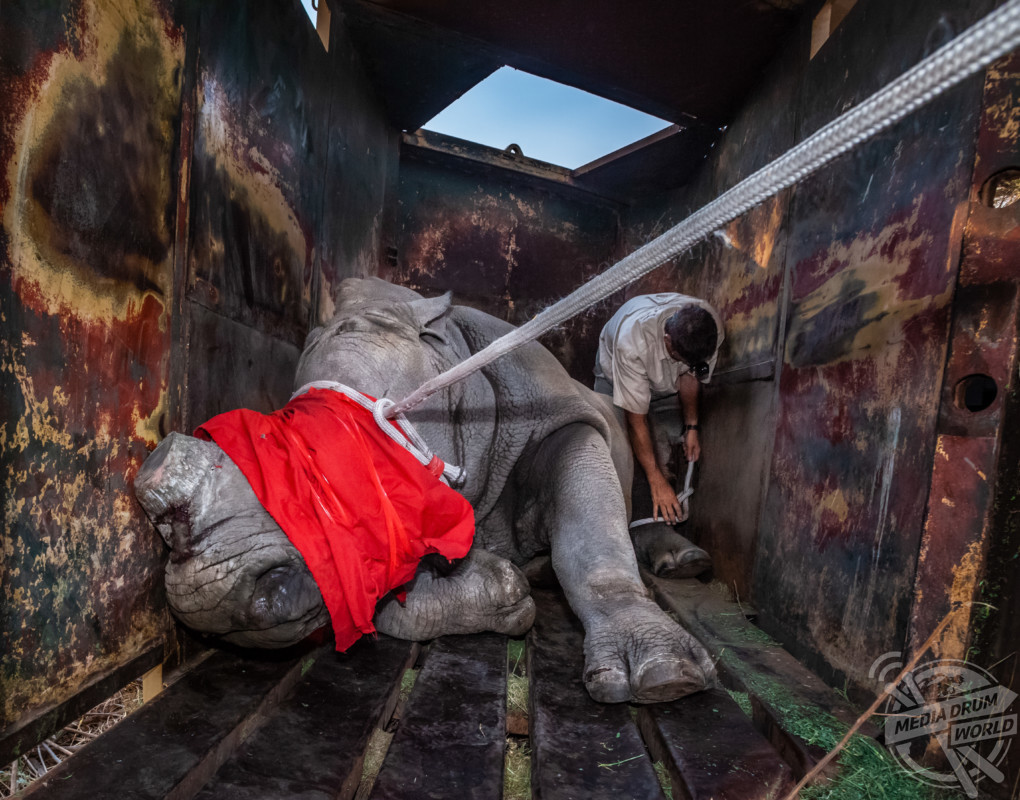
By Alex Jones
HEARTBREAKING photos show the plight of the thousands of rhinos who are poached for their ‘cancer curing’ horns and the inspirational people who are doing all they can to save the majestic but vulnerable animal.
The mesmerising images show a frightened and blindfolded rhino cowering in a shipping container after its horn was hacked off to fuel a billion-pound illegal trade, a considerate animal rights activist bottle feeding a rhino calf, and a mother rhino whose horn had been hacked off stoically protecting her child.

In the 1970s there were tens of thousands of rhinos across Africa, but now black and white rhinos have been pushed to the brink of extinction by relentless poaching.
Conservation photographer Neil Aldridge (37) who lives in Bristol but grew up in South Africa, has been following the plight of the rhino for years and captured these remarkable pictures taken across South Africa and Botswana.
“I began actively using my work to help raise awareness of the plight of rhinos back home in Africa in 2013 when I photographed a poaching survivor on a reserve in South Africa,” he explained.

“I was always drawn to focussing on the solutions, the survivor stories and the heroes.
“People need to know that there is hope and there are enough photographers trying to hunt out the bloodied corpses of endangered species to shock people into caring.
“So naturally I jumped at the chance to team up with the charity Rhino Conservation Botswana because the work being done there to bring rhinos back to a country that had lost them all to hunting and poaching represented the boldest step to saving these incredible animals.
“This was at a time when people were starting to give up and say, ‘maybe we should re-open trade in rhino horn.’

“For me, that was never an option for anybody serious about saving rhinos, only for people who wanted to get rich.
“I wanted the world to know that if you have the political will and the passionate people on the ground, it is absolutely possible to not only save rhinos, but to allow them to thrive.”
South Africa and Kenya have the highest levels of poaching. In 2013, 95 per cent of poaching occurred in these two countries.
Fuelled by demand from increasingly wealthy middle classes in China and Vietnam, rhino horn is illegally traded on the black market for its alleged medicinal properties.

Some believe rhino horn can cure cancers whilst other heartless buyers collect the horns to enhance their social status. It’s believed the trade generates nearly £13billion a year.
On the black market, horn sells for about £50,000 per kilo, making it one of the most valuable natural commodities on earth, worth more than gold.
Despite the devastation, Aldridge shines a light on the good work people are doing to help protect and save the rhinos in his stunning shots.
“I don’t just see a story about rhinos,” said Aldridge, who lives ‘off the grid’ for weeks at a time in order to capture the perfect photo.
“I see a story about people. The best people. I’ve been so privileged to work with vets at the Rhino Revolution orphanage in South Africa saving terrified calves orphaned by poaching, and with a team in Botswana that is repopulating a country with rhinos and working around the clock to keep them safe.

“On top of that, I remember every interaction with a rhino because, for me, it was never about just getting the shot.
“I hope that my respect for these animals comes through in my images. I spent long enough with many of these rhinos that I got to see their true personalities.
“And I feel privileged that they let me into their world long enough for me to tell their story.
“Because I always tried to focus on the positive elements of the fight to save rhinos, my wish is for people to be uplifted and to feel that there is hope.
“I have seen the effects of poaching first-hand, but I’ve never tried to seek out rhino corpses,” he continued.
“I don’t see the point. I’d rather leave that job to others because I always felt that I could make a greater impact on an audience with an empathetic picture of a poaching survivor or a calf that has watched its mother die at the hands of poachers.

“These are all effects of poaching too. A picture can lose impact if it makes people look away or turn the page.
“It’s been clear that for too long all that people have seen are images of butchered rhinos, the suffering caused and the human greed at the heart of the poaching crisis.
“I want people to know that there are passionate, dedicated people out there who deserve and need our support.
“Poaching syndicates are incredibly well funded, so to beat them we need to get behind these great projects.
“People respond so positively to my images as they can see that something is truly, finally happening. We have to be smarter as story tellers.”
For more information on the Rhino Conservation Botswana project, please click here.



